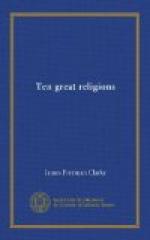10. Sou-Tsoung, the illustrious and brilliant emperor, erected at Ling-on and other towns, five in all, luminous temples. The primitive good was thus strengthened, and felicity flourished. Joyous solemnities were inaugurated, and the Empire entered on a wide course of prosperity.
11. Tai-Tsoung (764), a lettered and a warlike emperor, propagated the holy revolution. He sought for peace and tranquillity. Every year, at the hour of the Nativity (Christmas), he burnt celestial perfumes in remembrance of the divine benefit; he prepared imperial feasts, to honor the luminous (Christian) multitude.
* * * * *
21. This stone was raised in the second year of Kien-Tchoung of the great dynasty of Thang (A.D. 781), on the seventh day of the moon of the great increase. At this time the devout Ning-Chou, lord of the doctrine, governed the luminous multitude in the Eastern country.
Such is the translation of the famous inscription found at Si-ngau-Fou, in 1625. On the left of the monument are to be read the following words in the Syriac language: “In the days of the Father of Fathers, Anan-Yeschouah, Patriarch Catholicos.” To the right can be traced, “Adam, Priest, and Chor-Episcopus”; and at the base of the inscription: “In the year of the Greeks one thousand nine hundred and two (A.D. 781), Mar Yezd-bouzid, Priest and Chor-Episcopus of the Imperial city of Komdam, son of Millesins, priest of happy memory, of Balkh, a town of Tokharistan (Turkistan), raised this tablet of stone, on which are described the benefits of our Saviour, and the preaching of our fathers in the kingdom of the Chinese. Adam, Deacon, son of Yezd-bouzid, Chor-Episcopus; Sabar-Jesu, Priest; Gabriel, Priest, Archdeacon, and Ecclesiarch of Komdam and Sarage.”
* * * * *
The abridgment of Christian doctrine given in the Syro-Chinese inscription of Si-ngau-Fou shows us, also, that the propagators of the faith in Upper Asia in the seventh century professed the Nestorian errors.
Through the vague and obscure verbiage which characterizes the Chinese style, we recognize the mode in which that heresiarch admitted the union of the Word with man, by indwelling plenitude of grace superior to that of all the saints. One of the persons of the Trinity communicated himself to the very illustrious and venerable Messiah, “veiling his majesty.” That is certainly the doctrine of Nestorius; upon that point the authority of the critics is unanimous.
History, as we have elsewhere remarked, records the rapid progress of the Nestorian sects in the interior of Asia, and their being able to hold their ground, even under the sway of the Mussulmans, by means of compromises and concessions of every kind.
Setting out from the banks of the Tigris




